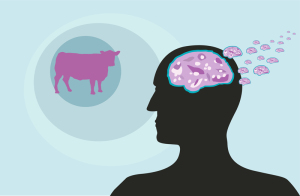Creutzfeldt-Jakob Disease is an infectious cause of dementia which is transmitted by a corrupted protein called prion and another name for this condition is therefore “prion disease”.
According to Ref. 12 the prion reprograms a gene at chromosome 20 to produce the prion protein, which is then accumulated by nerve cells in the brain causing the dementia of Creutzfeld-Jacob disease (CJD). A new variant of CJD is thought to be caused by the “human mad cow disease” prion. This causes bovine spongiform encephalopathy or BSE (mad cow disease in humans). The clinical course of this variant of human CJD is slower (up to a few years) compared to the more aggressive original CJD, where the patient lives only weeks or months (Ref. 13). CJD can be linked to corneal and liver transplants from donor patients who were infected unbeknown to the treating physicians. According to newer information from long-term follow-ups in England the incubation time between infectious exposure and the first symptoms of BSE can be as long as 15 years (Dr. R. Reynolds, Ref.16).
There is also a rare familial form , which is inherited as an autosomal dominant trait. This type occurs earlier in life and has a slower course. The other cases (the majority) affect adults at the age of 40 to 65. The symptoms are memory loss, blurred vision, dizziness. A dementia develops over weeks and months that affects all functions of the brain such as speech, thought, memory, reasoning and personal care.
Within the first 6 months a myoclonus develops, which is a muscle shaking condition. The physician will notice a hyperreflexia, some muscle atrophy and muscle fasciculations. Gait problems can develop as well due to cerebellar malfunctioning and the basal ganglia on the bottom of the brain can get involved leading to Parkinson disease – like symptoms.
Visual field defects are common, double vision and blurring of vision. Death occurs within 3 months to 1 year from the onset. Often pneumonia can complicate the clinical course.
Only 10% of patients live longer than 2 years. There is no known cure for CJD or the variant of CJD, although recently some success has been reported in stopping the spread of the disease with an old drug, pentosan polysulfate that was used in the past as a blood thinner and bladder medication. Caution needs to be taken to prevent transmission from handling fluids or blood from patients with CJD. For instance formalin or other standard sterilization methods are ineffective against the prion. Immersion in sodium hydroxide solution of 4% for 1 hour will be effective. When skin is contaminated, disinfection by a 10 minute exposure to 4% sodium hydroxide and subsequent thorough rinse with water is thought to be effective.
References:
1. OL Lopez et al. Neurology 2000 Dec 55(12):1863-1869.
2. K Yasojima et al. Brain Res 2000 DEC 887(1):80-89.
3. A Kontush et al. FreeRadicBiol Med2001Jan30(1): 119-128.
4. H Vanderstichele et al. Amyloid 2000Dec7(4):245-258.
5. Neely et al. Lipids 2000 Nov35(11):1249-1257.
6. RA Yokel Neurotoxicology 2000 Oct21(5):813-828.
7. Petanceska et al. Exp Gerontol 2000 Dec 35 (9-10):1317-1325.
8. MB Liddell et al. Brit J Psychiatry 2001 Jan 178: 7-11.
9. Sramek et al.ExpertOpinInvestigDrugs2000Apr9(4):899-915.
10.K Kosaka et al. Neuropathology 2000 March 20(1): 1-7.
11.V Haroutunian et al.Arch Neurol 2000 Aug57(8):1145-1150.
12. C Puckett et al. Am J Hum Genet 1991Aug49(2):320-329.
13. M Haltia Ann Med 2000 Oct 32(7): 439-500.
14. Ferri: Ferri’s Clinical Advisor: Instant Diagnosis and Treatment, 2004 ed., Copyright © 2004 Mosby, Inc.
15. Rakel: Conn’s Current Therapy 2004, 56th ed., Copyright © 2004 Elsevier
16. The 50th Annual St. Paul’s Hospital Continuing Medical Education Conference for Primary Physicians, Nov. 16 – 19, 2004







